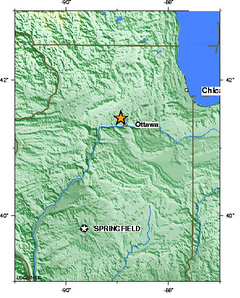From Wikipedia, the free encyclopedia, as it appeared on February 18, 2010

Date: June 28, 2004 01:10:51AM America/Chicago (2004-06-28T01:10:51Z)
Magnitude: 4.2 Mw
Depth: 5 km (3.1 mi)
Epicenter location: 41°26′35″N 88°55′37″W / 41.443°N 88.927°W / 41.443; -88.927
Coordinates: 41°26′35″N 88°55′37″W / 41.443°N 88.927°W / 41.443; -88.927
Countries or regions affected: United States
Tsunami: none
Casualties: none
The 2004 LaSalle County, Illinois earthquake was a 4.2 magnitude earthquake that occurred on June 28, 2004 at 01:10:51 a.m. CDT (06:10:51 a.m. UTC) and affected Northern Illinois. Its epicenter was located 2 miles (3.2 km) S of Prairie Center, 8 miles (13 km) E of Troy Grove, and 8 miles (13 km) NNE of North Utica, and could be felt as far away as Olive Branch, Mississippi.[1]
The earthquake was the first in LaSalle County since September 1972. It occurred 5 kilometres (3.1 mi) beneath the surface in a structure associated with the Sandwich Fault Zone. It was not connected with the New Madrid Fault farther south, which has been linked to the Midwest's most serious earthquakes. No fatalities were reported, yet thousands of people were startled and awoken in the middle of the night. Three nearby nuclear power plants — LaSalle, Quad Cities, and Dresden — issued low-level alerts, but no damage was found.[1]
See also
* List of earthquakes in the United States
References
1. ^ a b "Magnitude 4.2 - ILLINOIS". United States Geological Survey. 1 February 2010. http://earthquake.usgs.gov/eqcenter/eqinthenews/2004/uskgad/. Retrieved 16 February 2010.
External links
* USGS Earthquake Poster - Poster of the affected area, including historical data and Generalized Seismic Hazard
* * *
Analysis of Deletion (for wikigeeks only):
This article was deleted from Wikipedia on March 7, 2010 pursuant to a deletion discussion here. Eight editors (counting one unsigned comment from an IP address editor) voted to delete, and 4 voted to keep. Unfortunately 3 of those keep votes are from the same person, editor "Funandtrvl", which no one seemed to mention. It appears the article was improved before it was deleted, but the google cache version I was able to locate pre-dates those changes. The frequent-keep voter noted that she had added a "source that stated that it was the first earthquake in that county in 123 years, almost to the day", and also observed, "I still don't understand why everyone wants to delete the earthquake articles, but to keep 109,000+ association football articles, that seems to be okay. I can see everyone's priorities are sports, not science."
Perhaps not true! Oddly enough, at the same time this article was deleted, Wikipedia decided to keep its article on the smaller but more recent 2010 Illinois earthquake (which measured 3.8 vs. 4.2 for the 2004 quake). According to that deletion discussion there was a "substantial consensus for notability and keep(ing)" the article!!
How is this possible?! Let's see.... Of the eight delete voters for the 2004 quake, six also opined in favor of deleting the 2010 article. One didn't comment, and one voted to keep the 2010 article (but delete the 2004 article), apparently under the theory that the latter article could become a repository for all Illinois earthquakes. And in addition, a few other editors, who had not commented on the 2004 quake, chimed in with "keep" votes (in addition to the two editors who voted to keep both articles).
This is how things often work on wikipedia - whether an article nominated for deletion stays or goes depends on which random editors happen upon the deletion discussion and comment. The decisions are often made based on the opinion of 10 or less editors, out of the roughly 40,000 editors who make at least 5 edits per month. That's not to say 10 editors aren't enough to make a reasoned decision for the good of the Wikipedia project in some cases, but in anything other than an obvious delete (hoaxes, vandalism, attacks, spam, and unverifiable articles), or obvious keeps (episodes of Ugly Betty), the outcome can be dreadfully haphazard.
Footnote: At the same time as the above examples, Wikipedia decided to keep an article on the 2010 Eureka (Calif.) earthquake and ax one on the 2009 Inglewood earthquake. In short, Earthquake prediction itself is easier than deletion prediction.

No comments:
Post a Comment